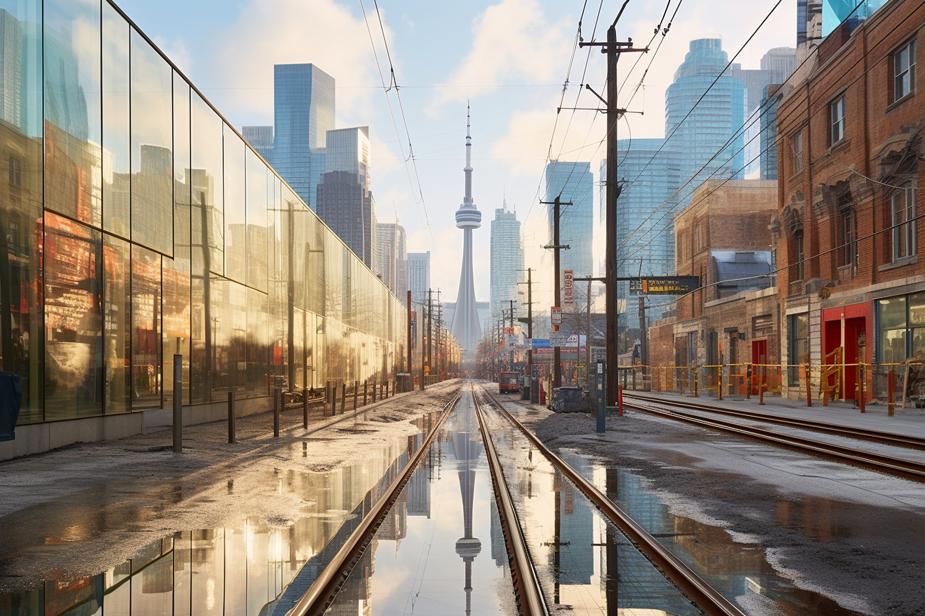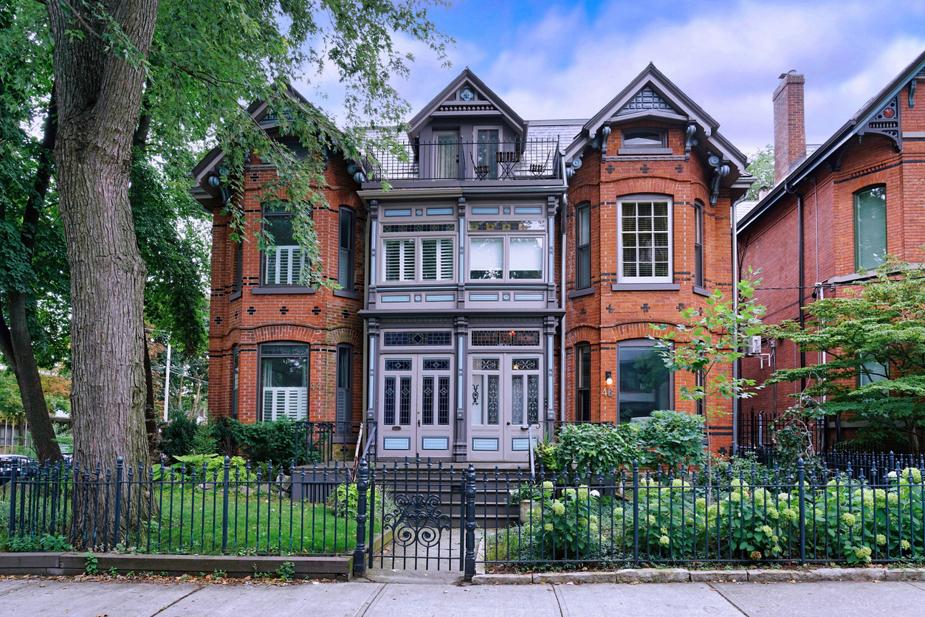
Toronto is a city in constant motion—steel cranes scraping the sky, subway doors sliding open to spill out crowds, new developments popping up faster than you can say heritage preservation. But some places in the city resist this forward march.
Some neighbourhoods don’t just preserve their history…they hold onto it with both hands. Not just in their architecture, but in their energy—where a turn down the right street, a glance at the right building, or a pause in just the right spot can make time stutter, fold, and pull you backward.
If you know where to look, Toronto isn’t just a modern metropolis. It’s a city layered with its past. In these neighbourhoods, time doesn’t move in a straight line.
The Junction: Where History Rebels Against Change
Prohibition, Factory Smoke, and Toronto’s Most Stubborn Neighbourhood
The Junction isn’t polished like The Distillery District. It isn’t curated or softened for tourism. It’s raw, unfiltered, and one of the few places in Toronto where history actively fights against modernity.
Then:
A neighbourhood shaped by train tracks, industry, and a century-long ban on alcohol. The factories that defined it were loud, gritty, and filled with workers who could build anything: train cars, furniture, textiles. But they couldn’t buy a drink. From 1904 to 2000, The Junction was under prohibition, a leftover law from when bar fights between factory workers were a daily occurrence.
Now:
The Junction today is a mix of restored industrial spaces and fiercely independent businesses. Its refusal to be overtaken by corporate chains keeps it feeling decades behind the rest of the city—in the best way.
Time Capsule Moment:
Walk into one of the area’s older buildings, and you might find a bricked-up entrance to an old speakeasy. They say some of them are still there, hidden beneath modern storefronts.
Thinking of Buying Here?
Loft conversions and historic homes sit next to repurposed factories, creating a mix of old and new that few neighbourhoods offer. The Junction is for buyers who want authenticity over polish, and Harvey Kalles Real Estate agents know which heritage properties here are worth the investment.
Liberty Village: From Factories to Trendy Living
Industrial Past, Modern Lofts, and the Fine Print of What You’re Actually Buying
Liberty Village has undergone one of Toronto’s most striking transformations. Once an industrial powerhouse filled with factories, textile mills, and even a military base, it has rapidly evolved into a dense, high-rise residential hub catering to young professionals and creatives.
Then:
Liberty Village was a working-class neighborhood defined by industry. The streets were lined with smokestacks, and workers lived in tightly packed housing just outside the factory gates. The area was all about production, not prestige.
Now:
Today, Liberty Village is one of Toronto’s most sought-after areas for high-rise condo living. While some historic buildings have been repurposed into trendy lofts, much of the neighborhood is now dominated by modern condo towers, offering skyline views and high-end amenities. The industrial-chic aesthetic remains, but the area is now one of the most densely populated condo districts in the city.
Time Capsule Moment:
Stand near the old Toronto Carpet Factory building, and you can still see remnants of original signage, iron fire escapes, and even old machinery repurposed into art installations—a nod to the area’s industrial past that lingers in the details.
Thinking of Buying Here?
In a neighbourhood where historic architecture meets modern renovations, it’s important to know what’s included when purchasing a home. Fixtures and chattels can vary, and understanding what stays with the unit is key before signing on the dotted line.

Cabbagetown: The Victorian Dream That Almost Vanished
North America’s Largest Collection of Victorian Homes (And The Stories Inside Them)
Walking through Cabbagetown feels like stepping into a Victorian novel. Towering red brick houses with ornate woodwork, sprawling porches, and stained-glass windows—each one telling a story that goes back more than a century.
While these homes once housed working-class families, today they are among the most sought-after historic properties in the city. For those drawn to the allure of Toronto luxury real estate, owning a restored Victorian masterpiece here means stepping into a home that carries a rich legacy while offering modern comfort.
Then:
Originally a working-class neighbourhood filled with Irish immigrants (who grew cabbage in their front yards, hence the name), Cabbagetown nearly disappeared in the mid-20th century when city planners wanted to demolish it for modern high-rises. The community fought back, and today, it’s one of Toronto’s most meticulously preserved historic areas.
Now:
Restoration efforts mean these homes aren’t just old—they’re alive with history. Many interiors still have their original fireplaces, moldings, and even gas lamp fixtures (converted for modern use).
Time Capsule Moment:
Visit Riverdale Farm, a piece of Toronto’s agricultural past that still operates within the city—a reminder that Cabbagetown was once farmland before urban expansion took over.
Thinking of Buying Here?
Owning a Victorian home means inheriting a piece of Toronto’s past, but it also comes with unique challenges: heritage restrictions, maintenance needs, and knowing what’s worth restoring vs. modernizing. The sales team at Harvey Kalles Real Estate has the expertise to help buyers navigate the joys (and realities) of Victorian homeownership.
The Distillery District: A Perfectly Preserved Past—Or Is It?
Where Toronto’s Industrial Heart Still Beats Beneath the Cobblestones
It’s easy to romanticize The Distillery District—cobblestone streets, gas lamps flickering in the evening, artists sketching in the shadows of 19th-century whiskey warehouses. It looks and feels like the past, but look closer, and you’ll see this isn’t just a relic—it’s a reinvention.
Then:
Founded in 1832, the Gooderham & Worts Distillery was a machine of industry, one of the largest distilleries in the world at its peak. It survived fires, economic crashes, and Prohibition. When the whiskey stopped flowing, it became a ghost town—abandoned brick warehouses standing in silence until the early 2000s.
Now:
Developers didn’t just restore The Distillery District—they transformed it into a curated experience of history. Every brick was carefully repointed, every street sign crafted to fit the aesthetic. It feels untouched, but in reality, it’s a stage set…a living museum where heritage and commerce collide.
Time Capsule Moment:
Look for the iron rings bolted into the brick walls—remnants of where horses were once tied up, their hooves echoing on the same stones you walk on today.
Thinking of Buying Here?
Heritage lofts inside converted warehouses give residents a chance to live inside history—with modern amenities tucked behind 150-year-old walls. Owning here means working with strict preservation regulations, something Harvey Kalles Real Estate specializes in navigating.
Parkdale: The Neighbourhood That Lost a Shoreline
A Ghost of its Former Grandeur, With a Secret Past Beneath the Pavement
Parkdale is one of Toronto’s biggest contradictions—grandeur mixed with grit, and history tangled with reinvention. But what most people don’t know? Parkdale is missing a piece of itself.
Once a prestigious lakeside neighbourhood, Parkdale was home to Toronto’s elite, with sprawling mansions lining the shores of Lake Ontario. Though much of its direct waterfront access was lost, Parkdale still holds onto its Old-World charm, much like other historic destinations across Ontario. Those drawn to heritage architecture, scenic landscapes, and a slower pace may also want to discover the charm of Prince Edward County—another region where history and character meet modern luxury. Harvey Kalles Real Estate has a new office on Main Street, Picton with a sales team specializing in County homes.
Then:
Once a wealthy lakeside neighbourhood, Parkdale was home to Toronto’s elite, with sprawling mansions lining the shores of Lake Ontario. Then, in the 1950s, the city decided to build the Gardiner Expressway—cutting Parkdale off from the waterfront forever. Mansions were demolished, the amusement parks disappeared, and the neighbourhood was never the same.
Now:
While many of the grand homes still stand (converted into apartments, inns, or restored residences), Parkdale now has an underground, artistic energy, as if it’s constantly trying to reclaim what it lost.
Time Capsule Moment:
Stand on the pedestrian bridge over the Gardiner at Jameson Avenue; it used to be a lake shore, and waves once lapped at the land beneath your feet.
Thinking of Buying Here?
Parkdale’s historic mansions, Art Deco apartment buildings, and century-old rowhouses offer a rare mix of Old-World elegance and affordability. Harvey Kalles Real Estate knows which homes still hold untouched architectural treasures inside.
Living Inside Toronto’s History
Toronto isn’t just a city of the future—it’s a city built on layers of time, and if you know where to look, you can still step inside those layers. Whether it’s a converted whiskey distillery, a loft inside an old textile factory, or a grand Victorian home with stories written into its walls, these neighbourhoods prove that history isn’t just something to admire—it’s something you can live in.
But buying a heritage home or a property in a historically rich area isn’t like buying just any home. Heritage designations, renovation restrictions, and hidden structural quirks can make the process both exciting and complex. That’s why working with an expert in Toronto’s historic real estate market is key.
If you’re ready to explore homes with history, meet the team of expert agents at Harvey Kalles Real Estate—leaders in helping buyers and sellers navigate the city’s most unique properties. Or, if you’re searching for a one-of-a-kind home that blends heritage charm with modern luxury, browse our exclusive property listings to find the perfect match.




